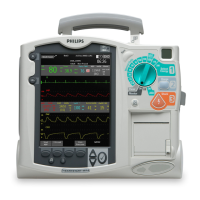4 ECG and Arrhythmia Monitoring Heart Rate and Arrhythmia Alarms
56
Heart Rate and Arrhythmia Alarms
The HeartStart MRx detects arrhythmia alarm conditions by comparing ECG data to a set of pre-
defined criteria. An alarm can be triggered by a rate exceeding a threshold (for example HR > XX), an
abnormal rhythm (for example, Ventricular Tachycardia), or an ectopic event (for example, PVC >
limit).
HR/Arrhythmia Alarms can be generated for the conditions shown in Tables 5 and 6. Once generated,
they appear as alarm messages in the alarm status area of the display located just above the HR
numeric. The notification of an alarm is indicated by both an audible and visual alert signal.
Arrhythmia Alarm Latching
Arrhythmia alarms are categorized as “latching” or “non-latching” alarms. Latching alarms are
announced and remain present, regardless of whether the alarm condition still exists, until they are
either acknowledged or a higher priority alarm condition occurs. Indications for non-latching alarms
are automatically removed when their alarm condition no longer exists.
Latching and non-latching alarms are categorized in Tables 5 and 6.
Table 5 HR/Arrhythmia Red Alarms
Alarm Message Condition Indicator Latching/
Non-Latching
Asystole No detectable beats for four
seconds in the absence of
Vfib
Red alarm message,
alarm tone
Latching
VFIB/VTACH A fibrillatory wave detected
for four seconds
Red alarm message,
alarm tone
Latching
VTACH Consecutive PVCs and HR
exceed configured limits
Red alarm message,
alarm tone
Latching
Extreme Brady 10 bpm below HR Low
limit, capped at 30 bpm
Red alarm message,
alarm tone
Latching
Extreme Tachy 20 bpm above HR High
limit capped at 200 bpm
(adult) or 240 bpm (pedi)
Red alarm message,
alarm tone
Latching

